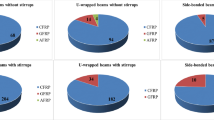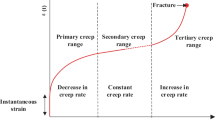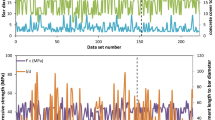Abstract
Timber is widely used as a construction material; however, the environmental deterioration of timber is a crucial problem for the construction industry. Fiber-reinforced polymer (FRP) has been considered appropriate and beneficial for the repair and rehabilitation of timber. This study proposes three empirical models using a supervised machine learning method called gene expression programming (GEP) to predict the bond strength between timber and FRP under various environmental conditions. The first empirical model is used to predict bond strength under standard conditions. The two other models are proposed to predict the strength reduction in acidic and alkali solutions. The formulation variables include duration, pH level, mechanical properties of FRP, types of timber and adhesive, and geometry of the specimens. In this regard, the database consisting of 251 test data is collected from previous studies. Eighty percent of the data is used for training the models, and the rest is applied to validation. Both training and validation data pass statistical criteria for all three models. The mean relative error is smaller than 12%, and the minimum R coefficient is 0.9 besides the appropriated root mean squared error (RMSE) and mean absolute error (MAE) values.












Similar content being viewed by others
References
Abdalla JA, Hawileh R, Al-Tamimi A (2011) Prediction of FRP-concrete ultimate bond strength using artificial neural network. In: 2011 fourth international conference on modeling, simulation and applied optimization. IEEE, pp 1–4. https://doi.org/10.1109/ICMSAO.2011.5775518
Alavi AH, Gandomi AH (2011a) A robust data mining approach for formulation of geotechnical engineering systems. Eng Comput 28(3):242–274. https://doi.org/10.1108/02644401111118132
Alavi AH, Gandomi AH (2011b) Prediction of principal ground-motion parameters using a hybrid method coupling artificial neural networks and simulated annealing. Comput Struct 89(23–24):2176–2194
Aval SB, Ketabdari H, Gharebaghi SA (2017) Estimating shear strength of short rectangular reinforced concrete columns using nonlinear regression and gene expression programming. Structures 12:13–23
Babatunde SA (2017) Review of strengthening techniques for masonry using fiber reinforced polymers. Compos Struct 161:246–255
Banzhaf W, Nordin P, Keller RE, Francone FD (1998) Genetic programming—an introduction: on the automatic evolution of computer programs and its applications, dpunkt. verlag and Morgan Kaufmann Publishers. Inc., San Francisco, California
Bolandi H, Banzhaf W, Lajnef N, Barri K, Alavi AH (2019) An intelligent model for the prediction of bond strength of FRP bars in concrete: a soft computing approach. Technologies 7(2):42
Carney P, Myers JJ (2003) Shear and flexural strengthening of masonry infill walls with FRP for extreme out-of-plane loading. In: Architectural engineering 2003: building integration solutions, pp 1–5
Daryan AS, Palizi S, Farhoudi N (2019) Optimization of plastic analysis of moment frames using modified dolphin echolocation algorithm. Adv Struct Eng 22(11):2504–2516
Daryan AS, Salari M, Farhoudi N, Palizi S (2021) Seismic design optimization of steel frames with steel shear wall system using modified Dolphin algorithm. Int J Steel Struct 21(3):771–786
Diab HM, Farghal OA (2014) Bond strength and effective bond length of FRP sheets/plates bonded to concrete considering the type of adhesive layer. Compos B Eng 58:618–624
Ferreira C (2001) Gene expression programming: a new adaptive algorithm for solving problems. arXiv:cs/0102027
Frketic J, Dickens T, Ramakrishnan S (2017) Automated manufacturing and processing of fiber-reinforced polymer (FRP) composites: an additive review of contemporary and modern techniques for advanced materials manufacturing. Addit Manuf 14:69–86
Galati N, Tumialan G, Nanni A (2006) Strengthening with FRP bars of URM walls subject to out-of-plane loads. Constr Build Mater 20(1–2):101–110
Gandomi AH, Roke DA (2015) Assessment of artificial neural network and genetic programming as predictive tools. Adv Eng Softw 88:63–72
Gandomi AH, Alavi AH, Arjmandi P, Aghaeifar A, Seyednour R (2010a) Genetic programming and orthogonal least squares: a hybrid approach to modeling the compressive strength of CFRP-confined concrete cylinders. J Mech Mater Struct 5(5):735–753
Gandomi AH, Alavi AH, Sahab MG (2010b) New formulation for compressive strength of CFRP confined concrete cylinders using linear genetic programming. Mater Struct 43(7):963–983
Garg A, Shankhwar K, Jiang D, Vijayaraghavan V, Panda BN, Panda SS (2018) An evolutionary framework in modelling of multi-output characteristics of the bone drilling process. Neural Comput Appl 29(11):1233–1241
Golbraikh A, Tropsha A (2002) Beware of q2! J Mol Graph Model 20(4):269–276
Kara IF (2011) Prediction of shear strength of FRP-reinforced concrete beams without stirrups based on genetic programming. Adv Eng Softw 42(6):295–304
Ketabdari H, Daryan AS, Hassani N (2019) Predicting post-fire mechanical properties of grade 8.8 and 10.9 steel bolts. J Constr Steel Res 162:105735
Köroğlu MA (2019) Artificial neural network for predicting the flexural bond strength of FRP bars in concrete. Sci Eng Compos Mater 26(1):12–29
Koza JR (1993) Hierarchical automatic function definition in genetic programming. Found Genet Algor 2:297–318
Lary DJ, Alavi AH, Gandomi AH, Walker AL (2016) Machine learning in geosciences and remote sensing. Geosci Front 7(1):3–10
Lim JC, Karakus M, Ozbakkaloglu T (2016) Evaluation of ultimate conditions of FRP-confined concrete columns using genetic programming. Comput Struct 162:28–37
Mashrei MA, Seracino R, Rahman MS (2013) Application of artificial neural networks to predict the bond strength of FRP-to-concrete joints. Constr Build Mater 40:812–821
Mitchell TM (1997) Does machine learning really work? AI Mag 18(3):11–11
Palizi S, Daryan AS (2021) Critical temperature evaluation of moment frames by means of plastic analysis theory and genetic algorithm. Iran J Sci Technol Trans Civ Eng 1–14
Palizi S, Daryan AS (2020) Plastic analysis of braced frames by application of metaheuristic optimization algorithms. Int J Steel Struct 20:1135–1150
Raftery GM, Harte AM, Rodd PD (2009) Bond quality at the FRP–wood interface using wood-laminating adhesives. Int J Adhes Adhes 29(2):101–110
Roy PP, Roy K (2008) On some aspects of variable selection for partial least squares regression models. QSAR Comb Sci 27(3):302–313
Saedi Daryan A, Palizi S (2020) New plastic analysis procedure for collapse prediction of braced frames by means of genetic algorithm. J Struct Eng 146(1):04019168
Toufigh V, Toufigh V, Saadatmanesh H, Ahmari S (2013) Strength evaluation and energy-dissipation behavior of fiber-reinforced polymer concrete. Adv Civ Eng Mater 2(1):622–636
Toufigh V, Yarigarravesh M, Mofid M (2017) Environmental effects on the bond at the interface of fiber-reinforced polymer and masonry brick. J Reinf Plast Compos 36(18):1355–1368
Toufigh V, Yarigarravesh M, Mofid M (2018) The long-term evaluation of FRPs bonded to timber. Eur J Wood Prod 76(6):1623–1636
Wan J, Smith ST, Qiao P, Chen F (2014) Experimental investigation on FRP-to-timber bonded interfaces. J Compos Constr 18(3):A4013006
Yarigarravesh M, Toufigh V, Mofid M (2018a) Environmental effects on the bond at the interface between FRP and wood. Eur J Wood Prod 76(1):163–174
Yarigarravesh M, Toufigh V, Mofid M (2018b) Experimental and analytical evaluation of FRPs bonded to masonry-long term. Surf Coat Technol 344:729–741
Yu QL, Glas DJ, Brouwers HJH (2020) Effects of hydrophobic expanded silicate aggregates on properties of structural lightweight aggregate concrete. J Mater Civ Eng 32(6):06020006
Zhang D (ed) (2006) Advances in machine learning applications in software engineering. Igi Global
Zoalfakar SH, Elsissy MA, Shaheen YB, Hamada AA (2016) Multiresponse optimization of postfire residual properties of fiber-reinforced high-performance concrete. J Mater Civ Eng 28(10):04016111
Author information
Authors and Affiliations
Corresponding author
Ethics declarations
Conflict of interest
The authors declare that they have no conflict of interest.
Additional information
Publisher's Note
Springer Nature remains neutral with regard to jurisdictional claims in published maps and institutional affiliations.
Rights and permissions
About this article
Cite this article
Palizi, S., Toufigh, V. Bond strength prediction of timber-FRP under standard and acidic/alkaline environmental conditions based on gene expression programming. Eur. J. Wood Prod. 80, 1457–1471 (2022). https://doi.org/10.1007/s00107-022-01838-y
Received:
Accepted:
Published:
Issue Date:
DOI: https://doi.org/10.1007/s00107-022-01838-y




